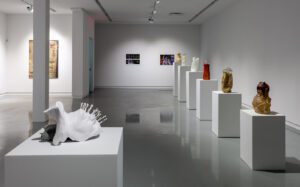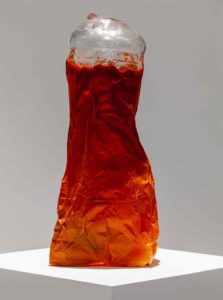
Phillip Barcio

Michael Joo’s latest solo exhibition at Chicago’s Kavi Gupta gallery is perfectly tailored to our time: exclusive and a little alienating, just like pandemic viewing restrictions.
Climbing the dimly lit stairway to the second-floor exhibition space by myself, my feelings of strange solitude were amplified by the sounds of soft, incomprehensible whisperings emanating from an unseen audio installation. Inside the gallery I was greeted by six glass sculptures set atop a line of white plinths descending in height. Eerily set aglow by dedicated spotlights in the otherwise darkened room, the sculptures resembled disposable paper or plastic sacks, like the ones you might see blown around in an urban alley, stuffed with empty bottles and cans or ripped up lottery scratchers.
Joo collected bags from the streets of New York, and inflated them with his own breath to create the molds for these works. He calls the series Single Breath Transfer. On a wall next to the line of sculptures, a pair of inkjet prints offer visual analyses of data points collected during the making process.
On another wall, two silver nitrate paintings belonging to Joo’s Various Low Mass Stars series read at first like purely abstract, nearly monochromatic works. Beside the paintings hangs a
selection of prints, documentation of the painting process. Joo made the paintings in situ, securing them to the ground inside abandoned architectural ruins and allowing their surfaces to be exposed to the elements. The paintings are like photographic echoes of a specific place in a specific span of time under specific conditions – analytical hyperrealism masquerading as formalist abstraction.
In the back of the gallery sit two sculptures of severed body parts. One is of the hollowed out face of Anne Sullivan, the teacher who dedicated her entire career to a single student, Helen Keller. The other is of the clenched fist of Abraham Lincoln. Both of these sculptures are riddled with projectiles resembling something between mushrooms and giant Q-tips.
In a darkened side gallery, the source of the whispering is revealed; it’s the soundtrack of a video of a neuroscientist, who has been filmed describing a series of human actions that she can see, but which we cannot see.
Watching the video heightened the sense that I was not so much a viewer in an art gallery as an interloper in an abandoned laboratory. I started to wonder whether I was being watched, and whether I was, in fact, the most important part of the show.
I called Joo and asked him about this feeling I had that I was somehow disconnected from the work, but also part of the work.
“Yes, exactly,” he said. “There’s a direct address in this show of the missing body.”
The Anne Sullivan and Abraham Lincoln body parts, Joo explained, were made from 3D prints of works in the Smithsonian archive.
“It’s kind of an evocation of literal body parts, avatars of the body,” Joo explains. “These objects are inaccessible right now, and yet, through this scanning technology, are available online to the public and therefore more accessible than ever.”
Joo then mentions almost as an aside that he has also starte d a YouTube channel, called SSDA ASMR, on which he is uploading more videos like the one in the show. They portray his collaborator, filmed from behind, performing whispered “cold reads” of artworks that the viewer of the video cannot see.
d a YouTube channel, called SSDA ASMR, on which he is uploading more videos like the one in the show. They portray his collaborator, filmed from behind, performing whispered “cold reads” of artworks that the viewer of the video cannot see.
“It’s about being dematerialized, but still having a presence,” Joo says. “It’s something that’s indexical, but constantly disappearing.”
The title Joo gave to this eerie and wonderfully fetishistic exhibition is Sensory Meridian. A meridian might refer to a high point, or a connective line between two locations. Or, in acupuncture or Reiki massage, a meridian is a pathway for life energy. Each definition suggests Joo was less interested in staging an exhibition of objects of art during Covid, and more interested in instigating experiences that agitate in favor of human curiosity.
Most of what lingers with me from Sensory Meridian is visual and auditory – memories of physical stuff – the sensory part. But Joo also got me with that idea of meridians. He’s raising important questions about connections and transmissions, and about when, how, and whether we are present.
Michael Joo: Sensory Meridian is on view through 10 April 2021 at Kavi Gupta in Chicago, 219 N. Elizabeth Street, Chicago, IL, USA.
Volume 35 no 4 March/April 2021

